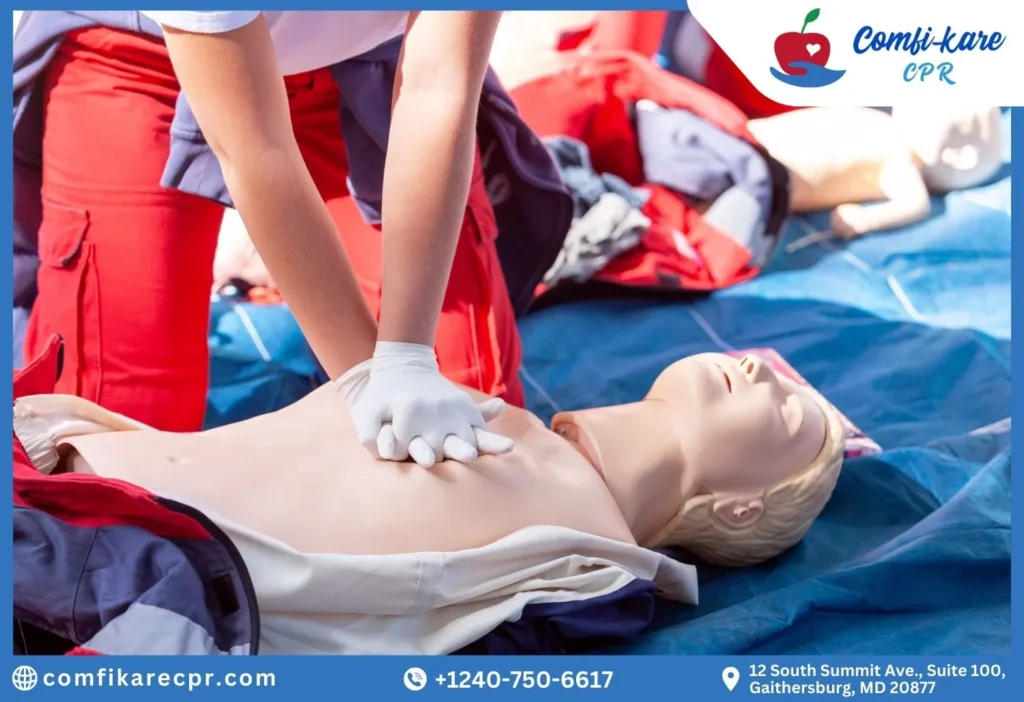
Imagine yourself walking or waiting outside a hospital when a person suddenly collapses on the ground. A moment of panic flows through everyone, as no one knows what the next step should be. This happens anywhere every now and then, but things can change with a simple cardiopulmonary resuscitation (CPR) technique.
Cardiac arrests have been a leading cause of death around the world. According to the Centers for Disease Control and Prevention, there have been more than 3,00,000 cases of cardiac arrest in the USA. All these cases of cardiac arrest happen outside of the hospital setting. Therefore, it is important to be prepared for a medical emergency that can happen anytime, anywhere.
In today’s blog, we are going to learn about CPR and how to get the certification. The best thing about learning CPR is that you don’t need to be a medical professional. Anyone can get CPR-certified, and there is no age bar. Only the person should be fit enough to provide CPR and must have knowledge of when to do it.
Take a look at the list of professions where a CPR course can make a difference.
Table of contents
- What is CPR?
- When should you give CPR?
- Steps to perform CPR?
- How do I get CPR certified?
What is CPR?
Cardiopulmonary resuscitation, or CPR, is a lifesaving technique that is performed when the heart stops beating. The manual pressure is applied to the heart to restore blood flow until a medical emergency arrives. Performing CPR on an individual increases the chances of survival if done timely.
However, it is necessary to learn the skills of performing CPR. For this, you don’t need to be a medical professional. All you need is a CPR training class where you learn about CPR guidelines and AED usage. As there have been various cases of sudden cardiac arrests in the USA, the federal government and the state government have taken various steps to increase CPR and AED awareness.
In this course, you learn:
- Effective chest compression
- AED usage
- The latest CPR and AED usage guidelines
- Knowledge about various medical emergencies
- Post-care cardiac arrest
- Safety measures for the rescuer and person
- Choking response
- Infant and child CPR
- Teamwork
- Better communication
When should you give CPR?
Cardiac arrests happen when the heart stops beating, which results in losing consciousness. CPR can be done on any person.
Here is the list of circumstances under which CPR is performed:
- When the individual collapses
- When the individual is non-responsive
- You find no pulse
- Most importantly, when the heart stops beating
Caution: Never perform CPR on a person who is alive or when the heart is beating. Manual pressure on a heart that is working can aggravate the situation and lead to a critical case. Read the difference between cardiac arrest and a heart attack to learn more about performing CPR.
Steps to perform CPR
It is important to learn the right way to perform CPR to increase the chances of survival during a medical emergency. In this section, we are going to learn about the steps to perform CPR on an adult.
Imagine you are on a road and you see a person collapse suddenly. You place your ear near his heart, but you do not hear any heartbeats. You checked the pulse and found nothing.
You understand that it’s time for CPR, and here is how it is done:

Step 1: Access the situation and do not panic
Step 2: Call the emergency number or 911
Step 3: Check whether the individual is breathing
Step 4: Apply effective chest compression
For this,
Step 1: Tilt the head back to open the airway
Step 2: Place the heels of your hand at the center of the person’s chest
Step 3: The other hand should be on top of the first hand
Step 4: Interlock your fingers and keep the elbows straight and not bended
Step 5: Shoulders should be directly parallel to your hand
Step 6: Compress or press the chest downward
Step 7: Continue compressing the chest until the medical emergency arrives
Step 8: Offer rescue breathing
Step 9: Continue doing CPR (30 chest compressions and 2 rescue breathing)
Step 10: Use AED, if present
Repeat this until
- The person starts breathing
- Medical help arrives
- You are exhausted
It is important to learn the proper CPR techniques and guidelines to avoid mistakes. Moreover, you can be a hero in those difficult times by saving a person. With the right CPR training, you can simply change the course of your life direction.
CPR certification in Frederick County, MD
Learning about CPR techniques is a rewarding experience. Of course, the primary objective is to save lives, but there are certain benefits to being CPR-certified.
If you have been looking for a CPR certification in Frederick County, there is nothing better than a CPR and first aid training course than Comfikare CPR. The trained staff offers CPR training classes at your preferred place so that you don’t have to think about rescheduling your commitments.
Also, you can recertify your CPR at quite an affordable price. This helps you know about the latest guidelines on CPR and AED usage during a medical emergency.
For more information on CPR certification, contact us.


